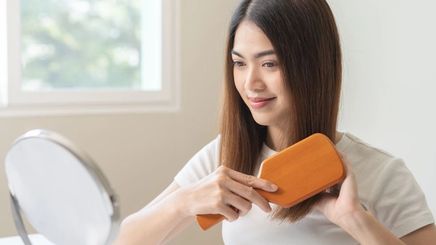
Those with oily hair are all too familiar with the daily struggle to keep it from looking flat and greasy. Here’s what happens: you step out of the shower feeling fresh and clean, only for your locks to look extra slick by midday. Flatness isn’t the only issue associated with excessive sebum – you could risk experiencing if you leave your condition untreated. Luckily, there are ways to manage this sebaceous situationship. Read on to find out how.
Use a Clarifying Shampoo
Fighting flatness begins in the shower. If you have oily hair or are an infrequent washer, a clarifying shampoo can help. It lifts impurities such as sebum, product residue, dirt, and bacteria from your scalp and strands. Most formulas are not for daily use, but some have moisturizers to keep your hair from going dry.
Try Dove Botanical Silicone Free Shampoo for Fresh Hair Clarify, which deep cleanses and freshens hair with white tea blossom extracts and 100% . You can alternate this gentle product with your regular shampoo or use it every wash day.
Condition Only the Ends
If you have oily hair, the last thing you want to do is pile product on your . Practice the proper way of applying conditioner to avoid making matters worse. After rinsing your shampoo, gently squeeze your hair to remove extra water.
Take a product like Dove Botanical Silicone Free Conditioner for Fresh Hair Clarify and apply just enough to coat the ends of your strands. Do not let it touch your roots and scalp, or you’ll undo your shampoo’s hard work.
Dry Your Hair Upside Down
Want volume? Dry your hair upside down. In case you haven’t noticed, combing or brushing away from your forehead makes your mane look flat. So, once your hair is only semi-damp, boost volume by upside down and brushing it back in place with your fingers. In addition, skip styling tools and techniques that smoothen your strands – your natural oils can do that for you.
Try Dry Shampoo
It’s not a cure-all, but dry shampoo is a quick fix for flat, oily hair. Made mainly of alcohol and starch, it absorbs grease and dirt, making days-old hair look cleaner. It can come in handy when you’re traveling or simply don’t have time for a . However, be careful about using it too often or you’ll end up with a clogged and itchy scalp.
Avoid Touching Your Hair
Dermatologists advise against touching your face for a reason: your hands carry germs and oil that can harm your skin. While you may not be that worried about growing pimples on your scalp, your digits can transfer oil onto your hair, too. If you already have an oil problem, that’s not ideal. So, avoid touching your locks, especially if they’re on the thinner side (or if you have ).
Watch How Often You Wash
Washing your hair too often can give you an oily scalp. Not washing it enough can have the same result. There’s no way to tell how yours would react, so prepare to be agile with your hair care. If shampooing your hair every other day makes it dry, limit wash days to three times a week. If your scalp becomes oily again, clean it more frequently. Employing a more intuitive approach may help solve your hair woes.
Work With What You’ve Got
In the meantime, make the most of your soft and naturally shiny mane by styling it in your favor. Put it in a sleek to disguise flat and limp locks. Your hair’s oils will help keep it in place – no pomade needed. You can also try wearing a with a deep side part. (Read: make it look flat on purpose!)Keep your ‘do looking fresh with some extra-hold hairspray.
Dealing with oily hair can be a huge hassle, but it’s common in where you start melting the minute you walk out the door. Try practicing the tips above to help you deal, but if greasiness persists, talk to your doctor for targeted treatments, especially if it’s accompanied by .